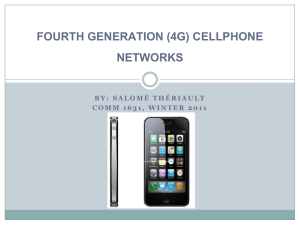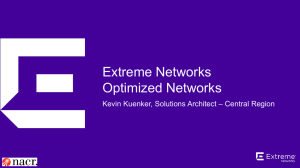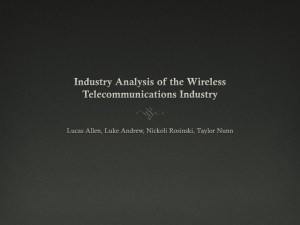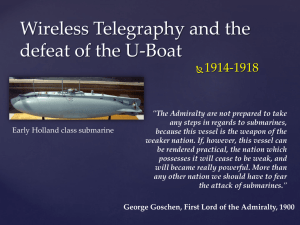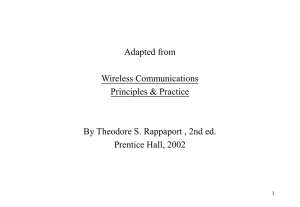Pattern - Mobile networks
advertisement
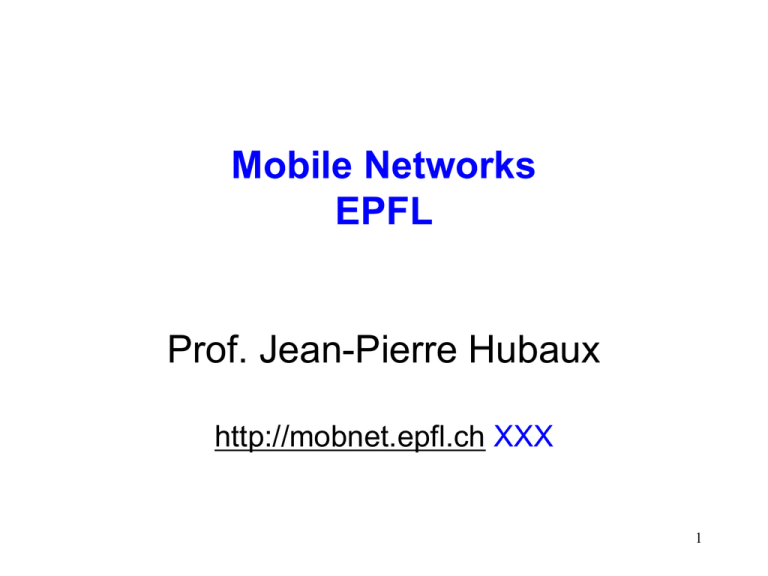
Mobile Networks EPFL Prof. Jean-Pierre Hubaux http://mobnet.epfl.ch XXX 1 About this course The course is about the system aspects of mobile networking Therefore, it covers: - networking issues (MAC, network and transport layers, principally) - estimation of network capacity and resource management - wireless security/privacy issues It does not cover: - radio propagation models - modulation and equalization techniques - source or channel coding - speech coding or other signal processing aspects - software-centric aspects (e.g., operating systems, mobile agents, smart phone programming) It is focused on mechanisms, and avoids as much as possible a detailed (and boring) description of standards However, it does propose an insight on IEEE 802.11 and on the security of WLANs and cellular networks Acronyms are abundant and we have to cope with them… The course is also an attempt to get closer to the “real world” Heterogeneity of the audience 2 Web site http://mobnet.epfl.ch/ Of particular relevance: - Calendar - Material (all slides used at the lectures, homeworks,…) - Previous exams 3 Recommended book D. P. Agrawal and Q.-A. Zeng Introduction to Wireless and Mobile Systems Third Edition, 2011 Cengage (hard copy or e-book) 4 Other Textbooks - M. Schwartz: Mobile Wireless Communications Cambridge University Press, 2005 - J. Schiller: Mobile Communications, Second Edition Addison-Wesley, 2004 http://www.inf.fu-berlin.de/inst/ag-tech/resources/mobkom/mobile_communications.htm - W. Stallings: Wireless Communications & Networks, Second Edition, Prentice Hall, 2005 http://www.WilliamStallings.com/Wireless/Wireless2e.html - L. Buttyan and JP Hubaux: Security and Cooperation in Wireless Networks Cambridge University Press, 2008 http://secowinet.epfl.ch Module A – Introduction (Part A1) 6 Wireless communication and mobility Aspects of mobility: user mobility: users communicate “anytime, anywhere, with anyone” device portability: devices can be connected anytime, anywhere to the network Wireless vs. mobile Examples stationary computer (desktop) Cable-Internet laptop in a hotel wireless LANs in historic buildings smart phone The demand for mobile communication creates the need for integration of wireless networks or mobility mechanisms into existing fixed networks: telephone network cellular telephony (e.g., GSM, UMTS, LTE) local area networks Wireless LANs (e.g., IEEE 802.11 or “WiFi”) Internet Mobile IP Examples of applications (1/2) Person to person communication (e.g., voice, SMS) Person to server (e.g., location-based services, timetable consultation, telebanking) Vehicles position via GPS local ad-hoc network with vehicles close-by to prevent accidents, guidance system, adaptive cruise control transmission of news, road condition, weather, music via Digital Audio Broadcasting vehicle data (e.g., from buses, trains, aircrafts) transmitted for maintenance Disaster situations replacement of a fixed infrastructure in case of earthquakes, hurricanes, fire etc. Military networks 8 Upcoming application: road traffic GSM, UMTS TETRA, ... http://ivc.epfl.ch http://www.sevecom.org 9 Examples of applications (2/2) Traveling salespeople direct access to customer files stored in a central location consistent databases for all agents mobile office Replacement of fixed networks Sensors trade shows networks LANs in historic buildings Entertainment, education, ... outdoor Internet access travel guide with up-to-date location dependent information ad-hoc networks for multi user games Location-dependent advertising 10 Location dependent services Location aware services what services, e.g., printer, fax, phone, server etc. exist in the local environment Follow-on services transmission of the actual workspace to the current location Information services „push“: e.g., current special offers in the shop nearby „pull“: e.g., where is the closest Migros? Support services caches, intermediate results, state information etc. „follow“ the mobile device through the fixed network Location-Based Services (LBSs) Foursquare, Facebook Mobile,… 11 Modern mobile phones Quad band GSM (850, 900, 1800, 1900 MHz) GPRS/EDGE Tri band UMTS/HSDPA (850, 1900, 2100 MHz) LTE GPS + accelerometers WiFi (802.11b/g/a/n) Bluetooth 12 Wireless enabled devices 13 Satellite Communications Supports 1100 concurrent phone calls Orbit altitude: approx. 780 km Frequency band: 1616-1626.5 MHz Rate: 25 kBd FDMA/TDMA Iridium 9555 Satellite Phone 14 Global Positioning System (GPS) 30 satellites currently Orbit altitude: approx. 20,200 km Frequency: 1575.42 MHz (L1) Bit-rate: 50 bps CDMA BTCC-45 Bluetooth GPS Receiver European attempt: Galileo Wireless “Last Mile”: WiMax WiMAX GP3500-12 omnidirectional antenna Frequency band: 3400-3600 MHz Gain: 12 dBi Impendence: 50 Power rating: 10 Watt Vertical beamwidth: 10 15 WiMAX PA3500-18 directional antenna Frequency band: 3200-3800 MHz Gain: 12 dBi Impendence: 50 Power rating: 10 Watt Vertical beamwidth: 17 Horizontal beamwidth: 20 Wireless sensors TelosB Sensor Mote Imote2 Cricket Mote Iris Mote IEEE 802.15.4 Chipcon Wireless Transceiver Frequency band: 2.4 to 2.4835 GHz Data rate: 250 kbps RF power: -24 dBm to 0 dBm Receive Sensitivity: -90 dBm (min), -94 dBm (typ) Range (onboard antenna): 50m indoors / 125m outdoors 16 MicaZ Radio-frequency Identification (RFID) SDI 010 RFID Reader ISO14443-A and B (13.56 MHz) Operating distance: 1cm Communication speed: up to 848 Kbit/s RFID tag 17 Medical Implants Implantable Cardioverter Defibrillator (ICD) Operating frequency: 175kHz Range: few centimeters Medical Implant Communication Service (MICS) Frequency band: 402-405 MHz Maximum transmit power (EIRP): 25 microwatt Range: few meters 18 Vehicular communications 19 Dedicated short-range communications (DSRC) Frequency band (US): 5.850 to 5.925 GHz Data rate: 6 to 27 Mbps Range: up to 1000m 19 Software Defined Radio Tuning Frequency: 30KHz - 30MHz (continuous) Tuning Steps: 1/5/10/50/100/500Hz & 1/5/9/10KHz Antenna Jacket / Impedance: BNC-socket / 50Ohms Max. Allowed Antenna Level : +10dBm typ. / saturation at -15dBm typ. Noise Floor (0.15-30MHz BW 2.3KHz): Standard: < -131dBm (0.06μV) typ. HighIP: < -119dBm (0.25μV) typ. Frequency Stability (15min. warm-up period): +/- 1ppm typ. Application: Cognitive Radios Dynamic Spectrum Access 20 Mobile devices Laptop • functionally eq. to desktop • standard applications Wireless sensors • Limited proc. power • Small battery Mobile phones • voice, data • web access • location based services RFID tag • A few thousands of logical gates • Responds only to the RFID reader requests (no battery) Pager • receive only • tiny displays • simple text messages PDA • simple graphical displays • character recognition • simplified WWW performance 21 Wireless networks in comparison to fixed networks Higher data loss-rates due notably to interferences emissions of e.g., engines, lightning, other wireless networks, microwave ovens Restrictive regulations of frequencies Usage of frequencies has to be coordinated, useful frequencies are almost all occupied (or at least reserved) Lower transmission rates From a few kbit/s (e.g., GSM) to a 100s of Mbit/s (e.g. WLAN) Higher jitter Lower security (higher vulnerability) Radio link permanently shared need of sophisticated MAC Fluctuating quality of the radio links Unknown and variable access points authentication procedures Unknown location of the mobile station mobility management 22 History of wireless communication (1/3) Many people in History used light for communication heliographs, flags („semaphore“), ... 150 BC smoke signals for communication (Greece) 1794, optical telegraph, Claude Chappe Electromagnetic waves are of special importance: 1831 Faraday demonstrates electromagnetic induction J. Maxwell (1831-79): theory of electromagnetic Fields, wave equations (1864) H. Hertz (1857-94): demonstrates with an experiment the wave character of electrical transmission through space (1886) 23 History of wireless communication (2/3) 1895 Guglielmo Marconi first demonstration of wireless telegraphy long wave transmission, high transmission power necessary (> 200kw) 1907 Commercial transatlantic connections huge base stations (30 to 100m high antennas) 1915 Wireless voice transmission New York - San Francisco 1920 Discovery of short waves by Marconi reflection at the ionosphere smaller sender and receiver, possible due to the invention of the vacuum tube (1906, Lee DeForest and Robert von Lieben) 24 History of wireless communication (3/3) 1928 Many TV broadcast trials (across Atlantic, color TV, TV news) 1933 Frequency modulation (E. H. Armstrong) 1946 First public mobile telephone service in 25 US cities (1 antenna per city…) 1976 Bell Mobile Phone service for NY city 1979 NMT at 450MHz (Scandinavian countries) 1982 Start of GSM-specification goal: pan-European digital mobile phone system with roaming 1983 Start of the American AMPS (Advanced Mobile Phone System, analog) 1984 CT-1 standard (Europe) for cordless telephones 1992 First deployment of GSM 2002 First deployment of UMTS 25 2010 - 2013 LTE standards mature, first trials Wireless systems: development over the last 25 years cordless wireless LAN cellular phones satellites 1980: CT0 1981: NMT 450 1983: AMPS 1982: Inmarsat-A 1984: CT1 1986: NMT 900 1987: CT1+ 1988: Inmarsat-C 1992: GSM 1991: CDMA 1991: D-AMPS 1989: CT 2 1992: Inmarsat-B Inmarsat-M 1993: PDC 1994: DCS 1800 analog phones 1998: Iridium 2000: GPRS 1991: DECT 2005: VoIP-DECT 2000: IEEE 802.11a,g 2009: IEEE 802.11n digital NMT: Nordic Mobile Telephone AMPS: Advanced Mobile Phone System (USA) CT: Cordless Telephone UMTS: Universal Mobile Telecom. System LTE: Long Term Evolution 1997: IEEE 802.11 1999: 802.11b, Bluetooth 2001: UMTS/IMT-2000 CDMA-2000 (USA) 2012 LTE 199x: proprietary 2010 UMA DECT: Digital Enhanced Cordless Telecom. DCS: Digital Cellular System PDC: Pacific Digital Cellular PAN: Personal Area Network UMA: Universal Mobile Access Areas of research in mobile communication Wireless Communication transmission quality (bandwidth, error rate, delay) modulation, coding, interference media access ... Mobility location dependent services, also called location based services location transparency quality of service support (delay, jitter) security ... Portability integration (“system on a chip”) power consumption limited computing power, sizes of display, ... usability ... Security/privacy 27 Reference model Application Application Transport Transport Network Network Network Network Data Link Data Link Data Link Data Link Physical Physical Physical Physical Radio link 28 Influence of mobile communication on the layer model Application layer Transport layer Network layer Data link layer Physical layer location-dependent services new applications, multimedia adaptive applications congestion and flow control quality of service addressing, routing, mobility management hand-over media access multiplexing security modulation power management, interference attenuation frequency allocation 29 Overlay Networks - the global view Integration of heterogeneous fixed and mobile networks with varying transmission characteristics wide area vertical hand-over metropolitan area campus-based horizontal hand-over in-house 30 References (in addition to the recommended textbooks) B. Walke: Mobile Radio Networks, Wiley, Second Edition, 2002 T. Rappaport: Wireless Communications, Prentice Hall, Second Edition, 2001 A. Goldsmith: Wireless Communications, Cambridge University Press, 2005 D. Tse and P. Viswanath: Fundamentals of Wireless Communication, Cambridge University Press, 2005 31

